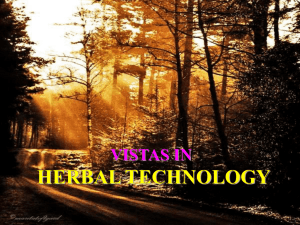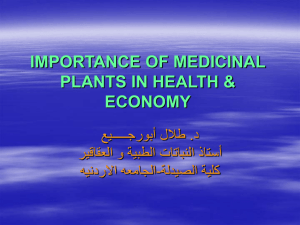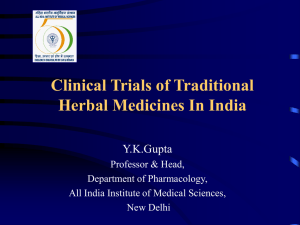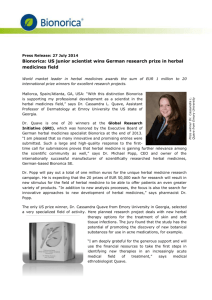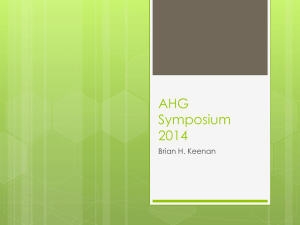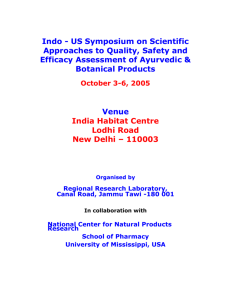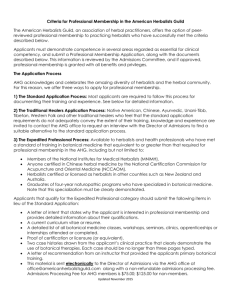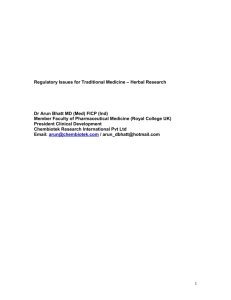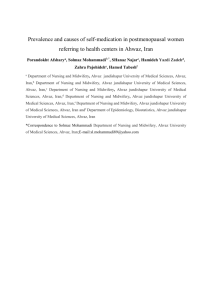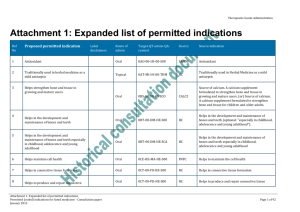56email lupin - Prof. Palpu Pushpangadan
advertisement
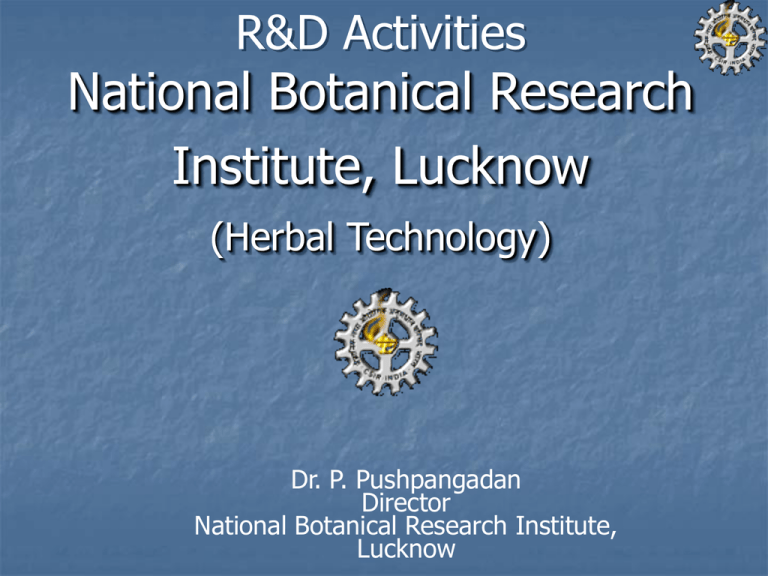
R&D Activities National Botanical Research Institute, Lucknow (Herbal Technology) Dr. P. Pushpangadan Director National Botanical Research Institute, Lucknow National Botanical Research Institute, Lucknow A premier plant research center of India under the umbrella of CSIR by undertaking both basic and applied research in various aspects of plant sciences for the conservation and sustainable utilization of plant genetic resources for human welfare and sustainable. Research Council Management Council Economic Botany Information Service Plant Biodiveristy and Conservation Biology Botanic garden and Floriculture (Dr. P. Pushpangadan) Information Liaison and Common Facilities Planning and Coordination Biotechnology and Plant Physiology Experimental Research stations Molecular Biology and Genetic Engineering Biomass Biology and Environmental Sciences House Keeping Auxilliary Genetics & Plant Breeding and Agrotechnology Microbiology & Plant Pathology Natural Product Development Mission The mission of the National Botanical Research Institute is: To act as a premier plant research centre of India under the umbrella of CSIR by undertaking both basic and applied research in various aspects of plant sciences for the conservation and sustainable utilization of plant genetic resources for human welfare and sustainable development. Vision To be a premier national and international centre on plant science research and development in the areas of plant biodiversity, conservation & sustainable utilization of non-crop and wild Plant Genetic Resources (PGR), bioprospecting, biofuels, bioinformatics and plant biotechnology. To be a prime catalyst in conversion of plant wealth into economic wealth in an ecologically sound and economically rewarding manner. To develop as a national referral centre for all knowledgebase related to plant biodiversity. Mandate To undertake both basic and applied research on plant sciences in taxonomy (including biosystematics and molecular taxonomy), conservation biology, pharmacognosy, ethnopharmacology, biomass biology, environmental sciences, microbiology, plant biotechnology (tissue culture and molecular biology including genetic engineering), plant physiology, Phytochemistry, genetics and plant breeding, floriculture and bioinformatics of the non-crop and wild plant genetic resources of India. MAJOR R & D PROGRAMMES Biodiversity research by inventorying, monitoring, assessment, conservation and sustainable utilization of plant genetic resources of India with special focus on medicinal, aromatic, dye Bioprospecting for search of commercially valuable genes, biodynamic compounds and development of scientifically validated, value-added and standardized noval plant products-herbal drugs, pharmaceuticals, nutraceuticals and cosmaceuticals. Biomass biology including biopesticides, biofuels and petroleum alternatives and environmental sciences including phytoremediation and abatment of terrestrial and aquatic pollution including studies on greenhouse gas emission. MAJOR R & D PROGRAMMES Biotechnology (biotech process/products) including trans-disciplinary studies on molecular biology and genetic engineering for development of transgenic plants. Genetics, plant breeding and agrotechnology Selection and genetic enhancement for development of new promising varieties of economically important non-crop plants. Bioinformatics by developing computerized/ electronic databases on Indian plants with special focus on medicinal, aromatic, dyes, gum and tannin yielding plants and products and applications of IT in plant science research. Herbal products developed by NBRI Herbal fermented drink Herbal Soft Drink Herbal lipstick (Luvstik) Herbal Gulal Nutraceuticals products Neem products Organic cultivation using microbial technology/ vermiculture etc. Products in pipeline Wound healing ointment Anti-ulcer formulation Anti-diarrhoreal syrup Anti-oxidant formulation Aims and objectives of Pharmacognosy & Ethnopharmacology Division To carry out detailed pharmacognostic studies which includes correct taxonomic identification of plants and it parts, macro- and microscopical details and histochemical analysis of the plant parts used as medicine. The SEM studies are also under taken for the identification/authentication of those commercial samples, which are available in broken or small pieces. To develop chemical markers for the identification, quality and batch-to-batch consistency of herbal drugs with the help of HPTLC, HPLC, GLC & DNA finger printings etc. Contd.. To develop physico-chemical standards of crude as well as finished herbal drugs/products. To detect the microbial contamination including the detection of mycotoxins in herbal drugs (raw as well as finished) in accordance with the latest WHO guidelines. To estimate concentration of heavy metals and pesticide residue in herbal drugs as per WHO guidelines. A small animal house and a pharmacology lab has also been established to cover the safety aspects or toxicity and other pharmacological evaluation of herbal products. Besides, the survey work for collection of authentic samples i. e. resource survey, market surveillance, shelf-life studies, seasonal and ecological variations, effect of ‘Shodhan Sanskar’ and scientific validation of ethnobotanical claims are some of the important activities of the group. The Current Innovation Herbal slimming/ anti obesity agent Based on certain traditional leads we have screened a large number of medicinal plants and identified the potential ones. Further screening narrowed down to the most promising ones. These were then subjected to detailed chemical and pharmacological standardization including the various ecotypes of the species selected. Contd… Activity guided extraction(s) and their various combination their of were made and evaluated pharmacologically. Various combinations were made with the help of the best Ayurveda experts. The final formulation (including standardized extracts) was made by a team of scientists drawn from Ayurveda, Pharmacognosy, Medicinal chemistry, Pharmacology and Pharmacy. Formulation Contain 4 medicinal plants. The extracts of the selected plants were lyophilized and used in the preparation of the final formulation. Chemical evaluation Some chemical moieties/marker compounds present in the chosen plants were identified. Chemo/ fingerprint profiling of the extracts were done using modern sophisticated techniques like HPTLC/ HPLC. Profiling of the final product was also recorded. Pharmacological evaluation S D Rats (over weight) were used in experimentation Monitored: Body weight profile Biochemical estimations Triglycerides Cholestrol Phosphilipids Pharmacological findings Over weight was significantly reverted back. Significant reduction in PHOSPOLIPIDS and CHOLESTROL TRIGLYCERIDE level was maintained in the treated groups. Toxicological evaluation Given orally does not shown any gross abnormality or mortality in acute toxicity studies IPR It is protected by patenting in US and PCT. Contact Dr. P. Pushpangadan Director National Botanical Research Institute, Rana Pratap Marg, Post Box 436 Lucknow-226 001 (U.P.) India Ph.: 0522-2205848, 2205839 Fax: 0522-2205836, 2205839 email: pushpangadan@satyam.net.in
